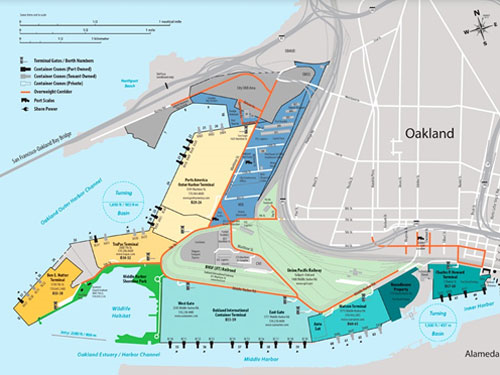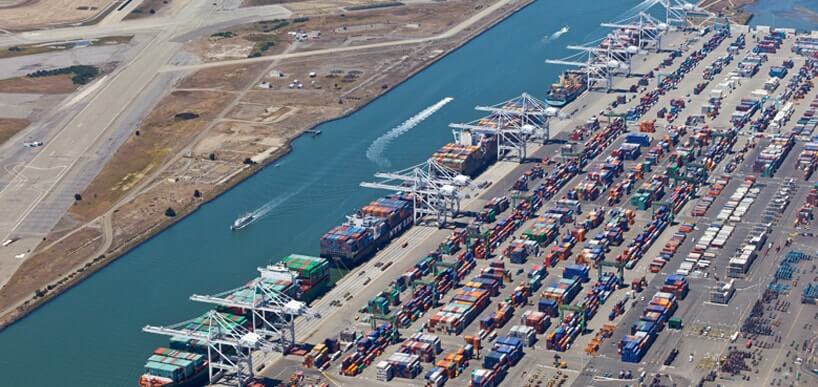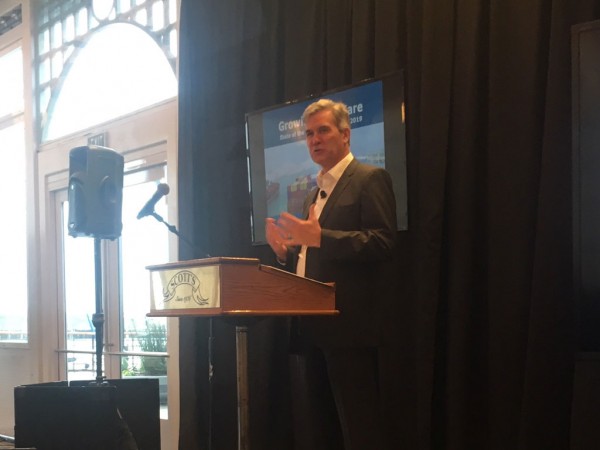The Stevedoring Services of America (SSA), general manager, who runs the Port of Oakland’s largest container terminal, Oakland International Container Terminal (OICT) says that the Port must quickly embark on an expansion of the Turning Basin located in the Oakland Estuary or face the loss of next generation container ship business.

In an interview with AJOT, Jim Rice, general manager SSA Terminals said that it became clear when CMA’s 18,000 teu (twenty-foot unit) container ship, Benjamin Franklin, docked at OICT three years ago that maneuvering the ship through the Turning Basin “was not going to work on a regular basis because the Basin was too narrow.”

Rice said that when the Benjamin Franklin arrived in Oakland on a trial visit in December 2015 “it was a challenge to get it in here. I went to the California Maritime Academy and watched the simulations for eight hours…. It was very tight and we were at the limit … of the Basin.”
He warned that “without that expansion of the Basin, we are not going to be able to handle the 18,000 teu ships while at the same time a number of terminals at (the Ports of) Los Angeles and Long Beach are preparing to do so.”
Today, OICT can “handle a 14,000 teu ship but the next jump is to 18,000 teus.”
With the support of the Port of Oakland: “We are making the investment in bigger cranes as are a number of terminals at the Ports of Los Angeles and Long Beach. The crane heights are going from 141 feet to 175 feet” but the investment will not be sufficient “without the expanded Turning Basin.”
Rice emphasized: “We have a good relationship with the Port, but it is urgent that plans move forward and that permit applications be made for the Basin expansion…. The big question is cost: who is going to pay for the expansion?”
A spokesman for the Port of Oakland provided AJOT with the following response:
“Any proposed expansion/modification to the Inner or Outer Harbor turning basins would be a partnership with the U.S. Army Corps of Engineers. The Corps has jurisdiction over improvements to the federal navigable channel. This would be a multi-year process. It would begin with a formal feasibility study to determine the potential scope, scale, environmental and economic impacts and preliminary estimate of cost associated with improvements. After a feasibility study and certification of environmental permits, a project would need formal authorization from Congress to seek future appropriations to meet the federal cost-share aspects of such improvements.”
In an interview with AJOT last January, Port of Oakland Maritime Director, John Driscoll, said that the Port has created an incentive program for SSA to order new mega cranes that have the height to service mega-container ships: “If we can’t handle those ships, they won’t come,” he said.
Driscoll noted that OICT is the Port’s biggest container terminal and so the berthing of the bigger ships must be able to work there. Right now, he says the biggest ships that can be handled at the Port have a 14,000 teu capacity and are about 1,200 feet long. The 18,000 teu ships are 1,300 feet long, he said.

Driscoll said that the Port is researching the possibility of widening the Turning Basin for the big ships to turn around and berth:
“We forecast that these 18,000 teu ships will be coming in within two to five years. Right now, the turning basis isn’t big enough. These are 1,300-foot-long ships and they cannot turn around…So, we are engaging with the Army Corps of Engineers and doing some simulations as to what the next step is… The best step might be to widen the Turning Basin. If that is the case, the permit process could take from 5-10 years and so we need to get started now” to process the necessary permits.
The Oakland International Container Terminal provides stevedoring services for 22 shipping lines serving Asia, Europe and Central America. The terminal handles approximately 100 vessel calls each month, discharging and loading predominantly containerized cargo.
The disposition of the Turning Basin also comes up in the plans of the Oakland Athletics’ proposed acquisition of Howard Terminal at the Port of Oakland for its new baseball park. Howard Terminal is located on the Oakland Estuary and adjoins the Turning Basin.
In January, Taj Tashombe, Vice President External Affairs, for the Oakland A’s, told the Propeller Club of Northern California that the Athletics “would be willing to relinquish some of the 55 acres we will be leasing to provide the space to accommodate a wider Turning Basin.”
While the A’s are willing to support the wider Turning Basin by giving up some land, Tashombe emphasized, the Port needs to provide a detailed plan detailing costs and timelines: “We need to know what the Port’s plan is.”

